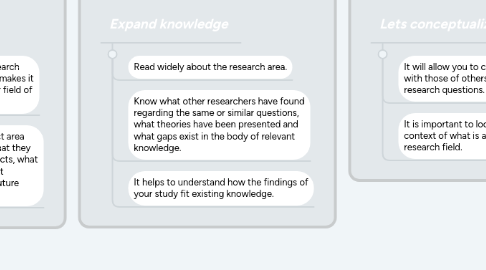
1. Functions
1.1. It provides a theoretical background to your study.
1.2. Establish links between what is proposed to study and what has already been studied.
1.3. It allows you to show how your findings have contributed to the knowledge existing in your profession.
1.4. Integrate research findings with existing knowledge.
2. Clarity and focus
2.1. It helps to conceptualize your research problem clearly and precisely and makes it more relevant and relevant to your field of research.
2.2. Learn what aspects of your subject area have been examined by others, what they have discovered about these aspects, what gaps they have identified and what suggestions they have made for future research.
3. Expand knowledge
3.1. Read widely about the research area.
3.2. Know what other researchers have found regarding the same or similar questions, what theories have been presented and what gaps exist in the body of relevant knowledge.
3.3. It helps to understand how the findings of your study fit existing knowledge.
4. Lets conceptualize
4.1. It will allow you to compare your findings with those of others and answer the research questions.
4.2. It is important to locate your findings in the context of what is already known in your research field.
5. How to review the literature
5.1. Conceptualize your research problem before undertaking your main literature review.
5.2. Four steps
5.2.1. 1. Searching for the existing literature in your area of study.
5.2.1.1. The internet
5.2.1.1.1. It is done through search engines:
5.2.1.1.2. Use keywords
5.2.1.2. Books
5.2.1.2.1. Advantages
5.2.1.2.2. Disadvantages
5.2.1.2.3. To consider
5.2.1.3. Journals
5.2.1.3.1. Prepare a list of journals:
5.2.1.3.2. Some sources to help in the search:
5.2.2. 2. Reviewing the selected literature.
5.2.2.1. Read critically.
5.2.2.2. Find relevant issues.
5.2.2.3. Separate themes - use sheets.
5.2.2.4. Develop the general framework.
5.2.2.5. Keep in mind theories presented.
5.2.2.6. Notice differences of opinion among researchers.
5.2.2.7. Determine areas that know little or nothing.
5.2.3. 3. Developing a theoretical framework.
5.2.3.1. The information obtained from different books and magazines should be classified according to the main themes and theories.
5.2.3.2. Reading part of the literature and then trying to develop a framework, even a loose one, within which you can organize the rest of the literature you read is the best strategy.
5.2.4. 4. Developing a conceptual framework.
5.2.4.1. Basis of your research problem
5.2.4.2. It arises from the theoretical framework and is related to the specific research problem.
